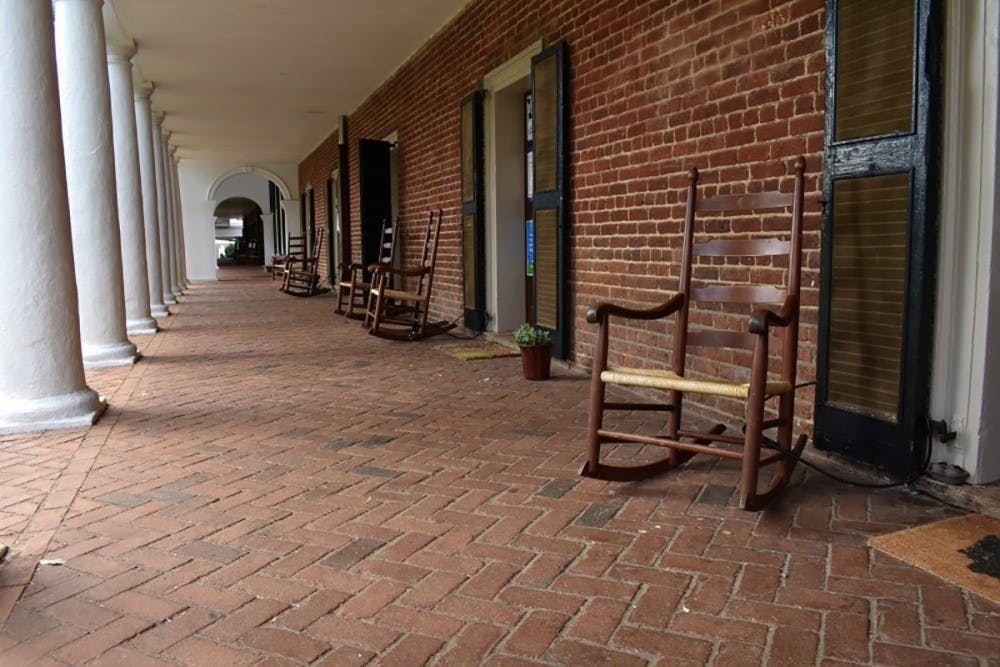Lea en español
Employees of the University’s Facilities Management Division were directed to take down a paper sign from the door of a fourth-year Lawn resident last week, according to a letter from Housing and Residence Life which the student posted on Twitter March 12. The tweet also included a photo of the sign alongside the letter and a caption saying “f—k uva.”
The sign displayed an image of the Rotunda — surrounded by flames and draped with a white hood resembling that of the Klu Klux Klan — in addition to a grim reaper holding a scythe and a police belt with the initials “UPD.” The words “Burn It All Down” were written below the Rotunda. Underneath the image was a quote from Kwame Ture — “In order for non-violence to work, your opponent must have a conscience” — followed by the phrase “UVA has none!”
This is not the first time the student has had a sign removed by the University. In October, there was controversy surrounding a sign condemning white supremacy that contained the phrases “F—k UVA.” and “UVA Operating Cost: KKKops, Genocide Slavery, Disability, Black and Brown Life.” The student’s sign led to other Lawn residents posting “F—k U.Va.” signs on their Lawn room doors as well.
University President Jim Ryan described the October sign as “deeply disappointing” in a written statement, though the University acknowledged that the signs were protected by the First Amendment. Following criticism of such signs from several alumni and community members, the University implemented additional restrictions on signage for incoming Lawn residents. Next academic year, residents will only be permitted to attach messages or paper materials to two message boards affixed to each Lawn room door by HRL.
In last week’s letter to the student, HRL said that the new sign advocates physical violence because the phrase “Burn It All Down” directly encourages a violent act.
“The quote included on the sign suggests that ‘nonviolence’ is ineffective against UVA, which further encourages violence,” HRL wrote.
The letter added that the student’s signs appeared in an area which was previously a site for race-based violence in August 2017, so there is greater potential for incitement by the sign’s words and images. As a result, HRL claimed taking down the sign was consistent with the First Amendment as it was necessary to safeguard the community.
“The threatening nature of this Lawn sign is particularly apparent in the face of recent history, including the fear and intimidation brought to the Lawn by torch-bearing rioters on August 11, 2017, the violence that continued the following day, and the January 6, 2021 insurrection at the Capitol that resulted in several deaths,” HRL wrote.
HRL noted that if this or a similar sign were to be posted on the student’s door in the future, she will be subject to further disciplinary action, including removal from University housing.
University spokesperson Brian Coy stated that University leaders came to the decision that the sign advocated physical violence and must be removed after consulting with legal counsel. He claimed that “University leaders have been vigilant in their protection of free speech in this community, even when such speech is critical of the University.”
“When speech goes beyond mere advocacy of a particular point of view and directly promotes physical violence, the University can and will take action to restrict it,” Coy said. “Removal of those signs is both necessary to protect community safety and consistent with our obligations to protect free speech.”
The Foundation for Individual Rights in Education — a nonprofit, nonpartisan organization dedicated to defending freedom of speech and due process rights on America’s college campuses — sent a letter to Gay Perez, assistant vice president of student affairs and executive director of HRL, raising concerns over the University’s response to the sign.
In the letter, Adam Steinbaugh, director of FIRE’s Individual Rights Defense Program, wrote that the University’s response violates the First Amendment because “the display does not amount to unprotected incitement” and thus does not fall under the limited classes of speech which are excluded from protection by the amendment.
Steinbaugh said that the student’s display “does not evidence an intent to direct others to engage in lawless action” and is not likely to result in imminent lawless activity. Additionally, Steinbaugh noted that the history of violence in Charlottesville should not dilute the student’s right to free speech.
“Instead, that violence — during which a white supremacist murdered a protester — should stiffen the University’s resolve to protect speech, not to use it as a basis to curtail expressive rights,” Steinbaugh said.
Katie Kortepeter, Media Relations Associate for FIRE, wrote in an email to The Cavalier Daily that the letter to University administration was a reminder that the student’s sign constitutes protected expression and a demand to rescind the removal of the sign.
“This is the second time in six months that her signs have caused a stir, but FIRE will continue to speak out to defend the First Amendment rights of students at U.Va. and around the country,” Kortepeter said.
The letter from FIRE requested a receipt of a response from the University no later than March 17 that would confirm it will not require that the student’s display be removed.







